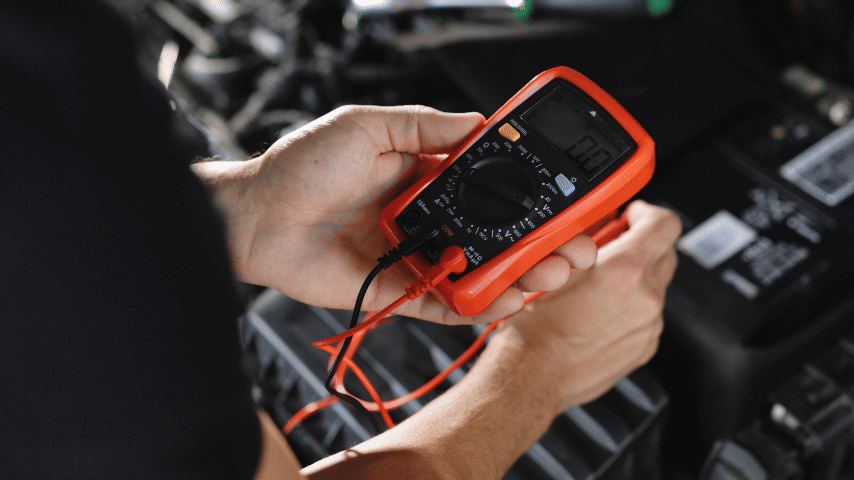Using your shop’s Cost of Doing Business (CODB) as a baseline for labor rates.

Locating the cause of an electrical fault can be a challenge even for the most experienced professional. I’m not referring to open circuits or even short circuits. These are relatively easy to find. In either case, the component, or load, won’t work. But the most common fault today is when a change in the overall resistance of the circuit occurs and that effects how the circuit load functions. It may work slowly or not at all.
And obviously, before you pick up your wrenches when dealing with car batteries, be sure to follow common safety precautions.
I’d ask you to make a small sample circuit so you can use your voltmeter to see for yourself the measurements and results I’m going to describe. It doesn’t have to be complex—all you need is some wire, a 12 V battery and a 12 V light bulb of any kind. A headlight works well (and you can use it later in your troubleshooting). Connect the headlight to the battery and we’ll start this conversation from here.
Connect your meter to the battery with your reference lead (the black lead) on the negative battery post as close the post as you can get. In any initial circuit tests, you want to check as much of the circuit path as you can at one time. Connect your measurement lead (the red lead) to the positive post of the battery. On a fully charged conventional flooded cell battery, you should read somewhere around 12.4 to 12.5 V.
Now for the disclaimer. I am not an electrical engineer, just a mechanic that is trying to fix the car in front of me. My explanations are necessarily simplified but I promise you that if you think of electrical troubleshooting the way I describe it, you will have more success than failure!
Once you have verified that nearly all the potential you started with got to where it was supposed to go, the next step is to move your measurement lead to the other side of the bulb, the ground side. Think a moment here. What do you think you should see for voltage potential now?
If you said 0.0 V you were pretty close! The voltage potential was used to allow the bulb to do its job and light up. There should be a little left over so the current can overcome any small resistances in the ground side of the circuit between the bulb and the battery. So maybe you’ll read 0.1 or 0.2 V on your meter.

Everything in the circuit has some resistance, but in relation to the device doing the work, the load, it is miniscule. That’s why you saw a slight loss between the battery positive post and the power side of the load. It is the same reason you saw a little left over when you moved your lead to the ground side of the load. These are expected and do not affect the operation of the load.
In the real world, there are several ways that the resistance in the circuit can change. Most commonly, there is some source of extra resistance, usually significant when compared to the load, that can cause the load to barely work or not work at all. Examples of factors that result in increased resistance include corroded battery terminals, wire harness connectors that are corroded or have pins that do not fit tightly into one another, and battery ground cables that are loosely attached to the frame or engine block.
With everything connected, it is time to grab your meter and take some measurements. Take three in the same order we did earlier; the first across the battery, the second with the measurement lead at the power side of the primary bulb, and the third at the ground side of the primary bulb. These are the exact same places you measured at when there was only the one bulb wired in.
It won’t be quite the same as what you started with. It will likely be significantly less as the thief takes a share of the available energy. This is in keeping with Kirchhoff’s Second Law. The key here is that you measured less than you expected to see, and this is your sign that there is a problem between where your measurement lead is now and where it was last. More in a moment.
The third measurement should show about the same as it did when you tried this technique the first time. Even though the primary bulb didn’t get as much as it wanted, it used what it got so you should only measure a few tenths of a volt on the ground side.
My next step as a technician would be to grab a wiring diagram for the circuit I’m working on and see what lies between the load and the battery on the power side of its circuit. Somewhere in there is the source of extra resistance that isn’t supposed to be there.
For our purposes, we’ll use the simple circuit you have in front of you. Move your measurement lead back to the power side of the primary bulb, the load. Again, you’ll see significantly less than the 12.4 V or so you started with. To find where the extra resistance is hiding, work your way back toward the battery until the reading returns to what you would expect it to be. Take your measurement lead and put it on the ground side of the thief. It should read about the same as it did when it was placed on the power side of the load. This is the leftover energy after the thief took its share. Now move your measurement lead to the power side of the thief. Here you should see what you expected to see at the load. This tells you you’ve passed the thief and to further isolate it, you just start moving back the other way in smaller increments. On a car, you’d use the wiring diagram to help you locate the most likely places for the problem to occur and the easiest places to take your measurements.

Move the thief bulb and install it between the load and the ground side of the battery. Visually, the results will be the same. Again, take your three measurements in the order you’ve been using so far. This time, you’ll first see what you have to work with in the battery, then what got to the load and finally, what left the load.
The first two should be normal readings showing you that most of what you started with got to the load. It’s that third measurement that throws people off. Consider if you were performing this test on a car’s headlight. Your reference lead is on ground and your measurement lead is on the ground side of the load. With both leads on ground (or so you think), most get confused when they see a voltage reading that is entirely unexpected.
With the test circuit you’ve built you can see the answer. The meter reading is telling you that the amount shown on the meter is the amount of electrical energy the thief downstream is waiting for. You aren’t just on the ground side of the load, you’re on the power side of the thief!
We tend to think that electrical energy moves through the circuit in a circle but get that out of your head. It moves at the speed of light, practically instantaneously, so a change in resistance on either side of the circuit will affect all of the circuit. Remember Kirchhoff? This is his second law in action. No matter where the resistances are located, they will all take their proportional share!
So when you see voltage of any significance on the ground side of the load in an operating circuit, that immediately tells you that the problem is between where you are and the negative battery post. Just keep moving your measurement lead to the battery and as soon as it drops to just a few tenths, you’ll know you’ve passed the extra source of resistance.
If you really want to master the art of electrical troubleshooting, print this out along with the other article I linked you to, and play with it until you feel that “ah ha “moment. Then, you’ll be ready to apply it to the next electrical fault you face.
The articles and other content contained on this site may contain links to third party websites. By clicking them, you consent to Dorman’s Website Use Agreement.
Participation in this forum is subject to Dorman’s Website Terms & Conditions. Please read our Comment Policy before commenting.